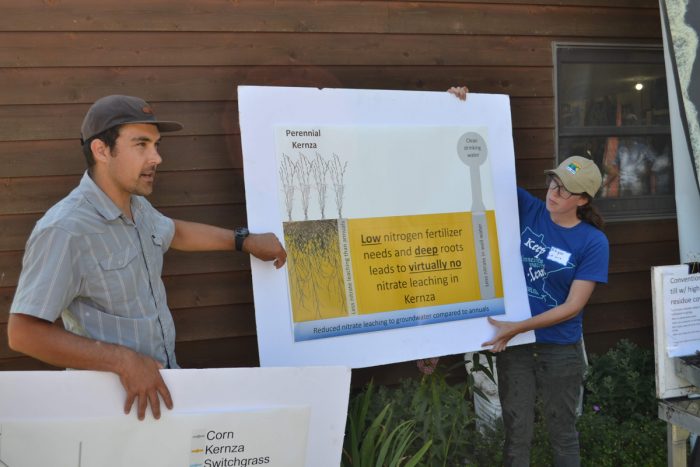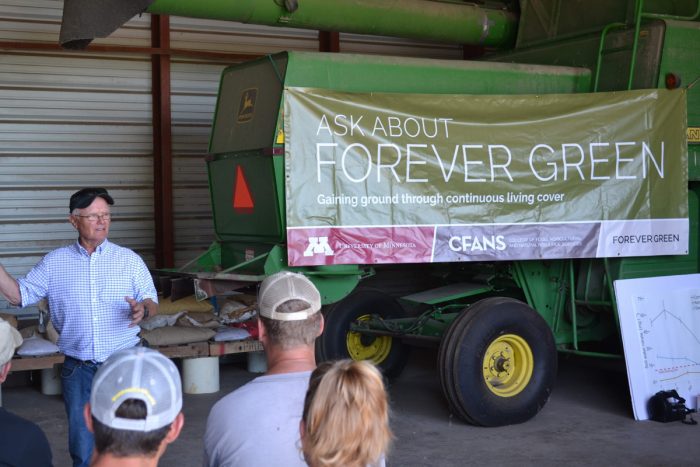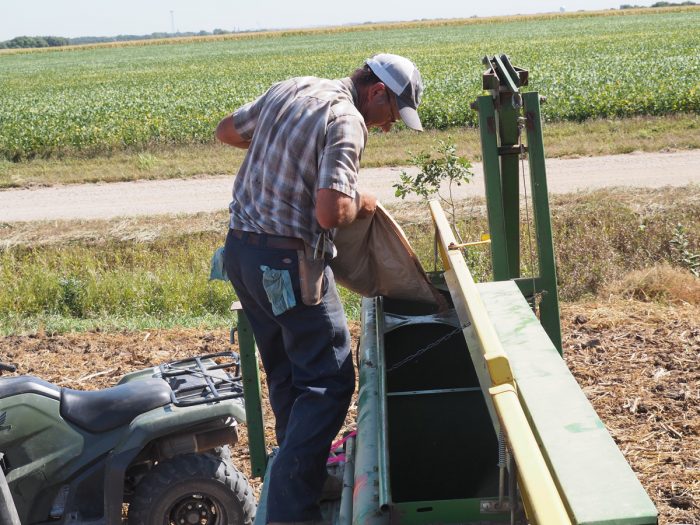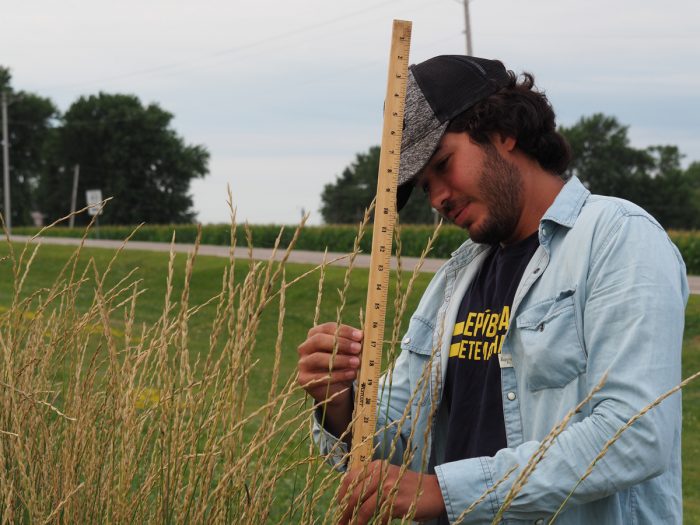At Bang Brewing in St. Paul, Minnesota, co-owner Sandy Boss Febbo keeps an 18-foot-long poster on the wall with photos of two grasses and their excavated roots. The first is a wheat plant and its roots measure about a foot long. The plant other is Kernza, a perennial grain with roots that measure over three feet long.
Boss Febbo points to the photos whenever she wants to explain the key ingredient in the hoppy yet easy-drinking Kernza IPA she serves. While most of her customers have never heard of Kernza, the long roots in the poster help her explain the value of perennial grains, which don’t need to be planted fresh every spring. Instead, they can grow year in and year out, and develop incredibly long roots that help prevent erosion, retaining water, and sequestering carbon, an important boon for climate mitigation. Perennials could prove especially important in the decades to come, as new research has shown that the carbon held in place by roots underground accounts for nearly half of the planet’s total carbon storage.
Kernza is the product of decades of research by The Land Institute, which is developing other perennial crops in hopes of helping “displace the industrial, disruptive system of agriculture.” And 10 years after the research institute trademarked it, it’s proving to be a promising ingredient.
“It works in beer, it works in crackers, pasta, salads, and bread—and it’s delicious,” says Boss Febbo. She’s also confident that when more people learn about the grain’s environmental benefits, “they’ll realize it’s a no-brainer.”
Boss Febbo has been brewing with Kernza for over three years, and yet hers is one of just a handful of businesses that are using the grain. Patagonia Provisions, the sustainable food company nested within the larger outdoor clothing brand, is also brewing with it, Cascadian Farms made a limited-run cereal with it (though it was hampered by low crop turnout), and until last year, it was at the center of the menu at the high-profile San Francisco restaurant Perennial, which closed recently.
But it has yet to hit the mainstream. And because the market for the grain is so small, there are only around 75 farmers growing Kernza in the U.S. today.
Now, a coalition of 50 farmers, scientists, educators, policy experts, and food industry leaders across the U.S. have received $10 million to scale up production and commercialize Kernza. The five-year initiative, called Kernza CAP, is led by The Land Institute and the University of Minnesota, and the coalition has received funding from the U.S. Department of Agriculture’s (USDA) National Institute of Food and Agriculture’s Agriculture and Food Research Initiative.
In order to bring the perennial grain to a wider audience, the Kernza CAP plans to go beyond farming and research, and will begin to hone in on production and supply chains, marketing and commercialization, and education. The project’s pitch to the USDA proclaimed that this project was not only a win for the environment but also a win for rural farmers, who have financially struggled under the commodity system, which in recent years has cost farmers more than they can sell their crops for. Instead, the researchers argue that Kernza can increase farmer income by greatly reducing the costs of tilling, synthetic fertilizer, and herbicide.
 A presentation on Kernza’s soil and nutrient benefits. (Photo credit: Connie Carlson)
A presentation on Kernza’s soil and nutrient benefits. (Photo credit: Connie Carlson)“Human life on this earth does not exist without healthy soil,” Tessa Peters, commercialization manager at The Land Institute, says. “We need grain crops [for foods] like bread, rice, pasta, and all of those are based on an annual agriculture, which is extractive. The development of a perennial agriculture that’s regenerative is essential to human life, because it means that we are not washing soil away, so we are able to survive the current existing climate crisis.”
How the Project Will Work
Luke Peterson grows 40 acres of Kernza at on his diverse 500-acre operation, A-Frame Farm, in Minnesota. He first planted Kernza in 2019, and is looking at the Kernza CAP with a long lens—one that goes beyond the five years dedicated to the project. “It’s not a crop that we can really compare to conventional row crops—it is its own thing,” he says.
Peterson says that after only a few harvests, he and other farmers working with researchers have helped improve the crop. “We’ve learned what kind of nutrients it needs, the soil it works best in, how to harvest it, and how to store it. We’ve got to start sometime, and this is a good way to get started on perennial agriculture.”
Peterson and the other participating farmers will carefully record their observations and data about planting, harvesting, processing, yield, and nutritional content. They will also take soil samples to measure biodiversity and nutrient levels before planting Kernza and periodically after. “We’ll be able to tell whether we’re building organic matter, and how microbial life has changed,” Peterson says. “We’ll be able to tell the nitrogen, potassium, and phosphorus levels.”
The environmental quality team, led by Dr. Jessica Gutknecht, assistant professor in the department of soil, water, and climate at the University of Minnesota, will then use data from farmers to model the way the Kernza plants help keep nutrients out of groundwater and water ways as well as how well they absorb and store carbon.
Kernza CAP lead Dr. Jacob Jungers, assistant professor of agronomy and plant genetics at the University of Minnesota, understands the importance of opening two-way communication channels between farmers and researchers so they can work together.
“We’ve done field days in the past with farmers to present some recent results from our research,” the agronomist says. “We need to interact with growers about what big questions need to be answered, and this project is going to facilitate that communication and distribution of information so that we can go back to the lab and conduct the studies needed to answer those questions.”




Getting farmer feedback has already been key to Kernza’s breeding process. Simplifying the dehulling process, for instance, will help streamline the work involved in growing it and in doing so it could encourage more farmers to grow Kernza.
“Right now, Kernza keeps half its hulls on during the harvesting process, and plant breeders are trying to make sure that more naked grains with fewer papery hulls come out during harvest,” Jungers explains. “We can overcome that challenge through breeding and genetics, but also through agronomy.” Jungers says the coalition will ask farmers to experiment with factors like the timing of the harvest, so that the plant is dryer when harvested and more of the grain will come out threshed.
In order to get more farmers to plant Kernza, its seeds will need to be larger, which can be a challenge with a perennial crop, Junger says. “Annuals produce big seeds or lots of them because they only have one chance, while perennials generally have smaller seeds or fewer of them,” the professor says. But Jungers also acknowledges that flavor and ease of use will be crucial to Kernza’s success.
Peterson agrees. “We’re not really focusing on yield; we’re more focusing on flavor and texture and the ecosystem services that Kernza can provide for land.”
Priming the Market
Tracy Singleton, owner of Birchwood Cafe in Minneapolis, believes that familiarizing the public along all levels of the supply chain—including restaurant and grain suppliers, bakers, grocery store owners, chefs, and consumers—will be vital to its success. To help popularize the grain and make a strong environmental point about what it can do, she started featuring Kernza on her menu in 2014. She wanted to “see what was needed to develop a supply chain that could scale.”
Over the past six years, Singleton has sounded the horn about Kernza in Birchwood Cafe email newsletters, social media, and press releases. She has featured Kernza on her menu at the Minnesota State Fair through a partner stall with the Minnesota Farmers Union, creating appetizing items like a Kernza eclair with a blueberry sweet corn filling and chocolate ganache and an heirloom tomato sweet corn BLT on Kernza focaccia bread. “We’ve created quite a buzz about it here in our local community, across the state, and even nationally,” Singleton says.
Singleton uses Kernza in both whole grain and flour form, in pancakes, waffles, grain salad, crackers, and a variety of baked goods. She especially likes its “subtle earthy, malty, nutty background flavor,” she says.
Singleton hopes to see puffed or rolled Kernza become available, so that it could easily be used in cereals and granola bars.
To streamline the supply chain, Tessa Peters says the plan is to form a business association. “It will be a polycentric governance mechanism to ensure all the players along the supply chain have input,” she adds. The aim is to create a model that’s replicable for other sustainable grains. “With the Business Association, growers and supply chain partners can communicate with each other about supply and demand and what it means to have fair pricing on both ends of the spectrum,” Peters says.




For farmers, growing Kernza will require something of a Goldilocks effect: Meeting demand without oversupplying the grain market will require them to get it just right. But Peters believes that if Kernza is priced correctly, and the market grows profitably, it won’t be a hard sell to farmers. And if it tastes right and is marketed favorably to consumers, it won’t be a hard sell to them. “It’s up to all of us to prove that it’s economically viable—it really won’t become mainstream until then.” (One thing the farmers of America may like: While spring wheat requires about 120 to 160 pounds of seeds per acre, Kernza requires only 15 pounds per acre because the plants reseed by nature.)
Education is Key
The Kernza Cap Project is banking on early education as a key driver of Kernza’s long-term adoption in the mainstream. A number of educators from University of Minnesota and The Land Institute are developing agroecology curricula for middle school through graduate school that emphasizes the farming side of the equation—including agronomy, rural sociology, and ecosystem services—as well as the product side, including product development, supply chains, and marketing.
“We really want to make sure that students understand the importance, not just of Kernza, but of and how important perennials can be to solving the climate change-based problems we’re all going to be facing,” Peters says.




To illustrate the importance of perennials, Peters says they’ll employ “photos that show a farmer pulling up dark, rich soil from under perennials, and we’ll take that a step further and show that every time that farmer tills the soil, some percentage of that soil blows away, with wind or washes away when it rains. We’ll teach children that the thing left underneath it, bedrock, cannot support human life, and that an inch of soil [gets built] in a million years.”
Peters says multimedia will be indispensable in educating younger populations, but age is critical. “The education arm is focused on targeting younger kids because they’re the ones who are really going to be grappling with the consequences of agriculture as it stands today.”
Jungers says that getting the message across to students isn’t hard when “we have this case study right in front of us.” Jungers is referring to Minnesota’s rural drinking water, much of which is derived directly from the ground. Nitrogen levels in water have risen due to fertilizers from annual crops like corn and soybeans, particularly in southern Minnesota.
“It’s come to a point where nitrogen levels have exceeded EPA drinking levels, and we’re investing a lot of money cleaning out nitrogen,” Jungers says. “Communities are directly impacted because they have to pay for it.”
Kernza, on the other hand, absorbs nitrogen and keeps it from leaking into to local waterways, and ultimately to larger bodies of water such as the Gulf of Mexico.
“A lot of our environmental impact research will be focused on reduction of nitrogen under a Kernza field versus a business-as-usual field, and that’s where we’ll be interacting with high school students and 4-H,” says Junger.
Jungers has been impressed with the educational curriculum he’s seen so far. In September, he traveled to Cold Spring, Minnesota, to meet with 10 Future Farmers of America (FFA) students who were planting Kernza right next to their school, Rocori High School. The school paid for the seed and rented the field, and Jungers assisted in helping plant the crop. Then the students made a short video and explained to the audience why they were planting a perennial grain. “The students blew me away with how well they got it,” Jungers said.
Ultimately, that tendency for most people to “get it” when presented with the facts about Kernza is what gives everyone involved in the Kernza Cap Project hope, even if the road ahead to mainstream adoption will be a long one.
“If we all demand that food is cheap, I don’t think Kernza will be a very good fit,” said Peterson, the Minnesota farmer. “But if we look at water quality, climate change, and soil health, and we work together on it, Kernza will be very popular.”
Except where noted, all photos courtesy of Jacob Jungers.